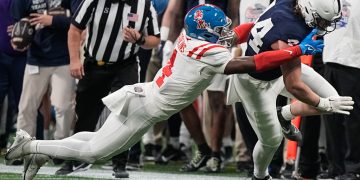
For the past year, the term conference realignment has defined college athletics. It started with Texas and Oklahoma deciding to leave the Big 12 in favor of the SEC back in late 2022, but it has since spread to each Power 5 conference and many more Group of 5 conferences.
As is custom for many discussions about NCAA sports, football stood at the center of these realignment negotiations. With sports talk shows speculating how Washington, Oregon, USC and UCLA will fare against the already stacked Big Ten football lineup, many people have forgotten that sports other than football exist.
The new age of conference realignment pays no attention to geography, seeing as Stanford, which is in California, will be in the same conference as the University of Miami in Florida. This is not inherently a problem for football, but are major concerns for tennis, golf, volleyball, softball, track and field and many other smaller sports about travel, players’ mental health and the overall logistics of realignment.
The effects of realignment are going to hit every conference, however big or small those repercussions may be. Some conferences, like the SEC, will only have to travel marginally farther distances to play away games, but other conferences, like the ACC, Big 12 and Big Ten, are spread over three to four time zones.
Do smaller sports have enough money to pay for all of this travel? How much class time will student athletes miss because of the travel required for cross-country matchups? From the outside, realignment seems like a good thing, but what do coaches and players think about this change?
In May, Missouri Head Football Coach Eliah Drinkwitz said, “Look, my question is, did we count the costs? I’m not talking about a financial cost. I’m talking about did we count the cost for the student athletes involved in this decision? What cost is it to those student athletes?” He continued, “We’re talking about a football decision (that) they based off football, but what about softball and baseball, who have to travel cross–country? Did we ask about the cost of them?”
Football has always been the biggest money-maker for college athletics, and it seems as though realignment solidified that. It is no secret that these conference switches will make for some very entertaining and competitive college football seasons, but at what cost to the rest of the college sports?
Drinkwitz said, “Do we know what the number one indicator of symptom or cause of mental health is? It’s lack of rest and sleep. Traveling in those baseball (and) softball games, you know, those people, they travel commercial, they get done playing at 4 o’clock, they come back, it’s 3 or 4 in the morning, they have to go to class,” he said. “I mean, did we ask any of them?”
All-American University of Oregon softball player Terra McGowan said on X, formerly known as Twitter, “Has anybody thought about the repercussions that conference realignments have on student athletes’ quality of life?” McGowan wrote. “You’re asking them to travel across the country every other weekend while balancing school and a social life??? This needs to be talked about more.”
Since McGowan posted this, more and more people are becoming aware of the negative sides of conference realignment; however, the damage is done, and college athletics may never return to its former state.
The NCAA claims to fight for the well-being and success of its athletes, but it may have missed the mark in protecting said athletes from conference realignment.
Morgan Scott, one of McGowan’s former teammates said, “(Is) anyone going to talk about all the other sports that play multiple games in a weekend?” Scott wrote. “What happened to (the) mental health of student athletes being important? The balance of practice, travel, school, and having a social life is already hard enough. Why add even more stress?”



























